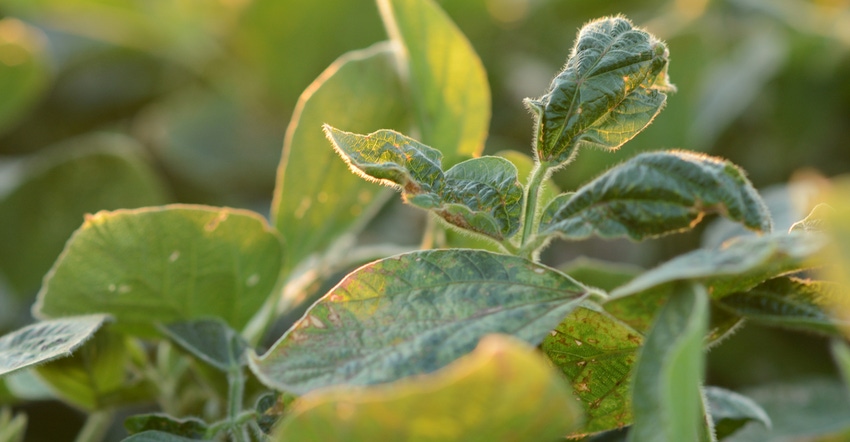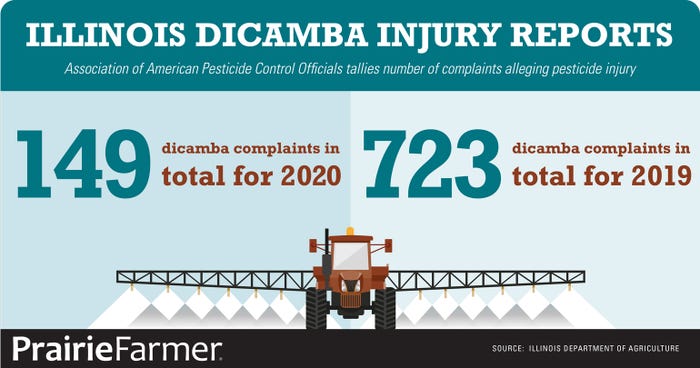
Illinois had fewer dicamba-related pesticide misuse complaints in 2020 than it’s had in any year since 2017, when USDA first approved the chemical trait platform for postemergence applications on soybeans.
With just 149 dicamba-related complaints this year, compared to 723 in 2019, the number decreased nearly 80%.
Related: Dicamba brings in record number of complaints
Six counties in eastern Illinois, where half of the state’s dicamba misuse complaints flared in 2019, were also impacted by a dry spell during July that year. The region avoided similar conditions in 2020 during the weeks leading up to June 25, the dicamba application deadline set by the state. Fewer than 20 complaints were filed in the Champaign County region this year.
In 2019, hot and dry weather allowed for volatilization and movement of dicamba up to four days after application, which occurred until mid-July after the Illinois Department of Agriculture extended the deadline. Doug Owens, chief of the Bureau of Environmental Programs, says that’s why Illinois received a record number of complaints last year.
“Weather was the main factor for a rise in cases in 2019, and that makes me think weather again is the main factor in 2020’s decline,” Owens says.

Owens says that without rain, dicamba doesn’t mix into the soil. This makes it vulnerable to volatilization, which starts to occur at 70 degrees F.
Dicamba was also applied on fewer acres, says University of Illinois weed scientist Aaron Hager. He says fewer applicators were willing to apply the chemical in 2020 due to Illinois-specific restrictions, such as a requirement that dicamba can’t be applied any day where the forecast shows temperatures could rise above 85 degrees F.
“There were a lot of acres I suspect were not treated with dicamba, because of either the temperature or 45-day restriction,” Hager says, referring to the amount of time farmers have to apply dicamba after planting in Illinois.
Compound effect
Soybean varieties susceptible to dicamba will eventually recover from exposure, but without rain, the recovery will be delayed.
“There were fields in Champaign County that cupped up for six weeks because it was so dry in 2019,” Hager says. “In a normal year, considering these low-dose exposures, these plants tend to recover quickly. Last year, they didn’t.”
That happened in west-central Iowa this year, where dry conditions set in after planting and made it harder for vulnerable soybeans to recover from exposure to volatilized dicamba.
“We caught rain, and I think that helped a lot. But some farmers in Iowa had a 2020 that was a lot like the 2019 eastern Illinois experienced,” says Jean Payne, president of the Illinois Fertilizer and Chemical Association.
Hager agrees that could help explain why Iowa had a surge in complaints this year like Illinois did in 2019. The Iowa Department of Agriculture and Land Stewardship reports 215 growth regulator herbicide complaints in 2020; ongoing investigations show at least 31 were dicamba-related. In 2019, there were 132 growth regulator herbicide complaints, and the agency confirmed 83 were dicamba-related.
“Anymore, the complaints we’re seeing aren’t obviously physical drift. The most common form of injury we see is where injury symptoms are uniform across the entire track,” Hager says, pointing to volatilization of dicamba as the only way he knows soybeans can exhibit whole-field symptomatology.
He says as more farmers switch to Enlist soybeans, which are vulnerable to dicamba, 2021 promises to be like 2020 in Illinois: “There’s progress, but unless you have 100% adoption of dicamba, there’s always going to be some damage.”
The million-dollar question: How widespread will it be?
“I can’t predict the weather, so I can’t say,” Hager says.
When it comes to the temperature and timing restrictions put in place by Illinois, Payne says they’ve helped bring down the number of complaints. Owens says his office would likely keep the restrictions in place if the 2021 federal EPA labels for dicamba don’t include similar restrictions. EPA is expected to release the 2021 label in the latter part of October.
“We can’t control the rain, but at least we can control when we apply,” Payne says. “It makes a big difference when complaints peak in June, like we did this year, and not in August, like we did in 2019.”
About the Author(s)
You May Also Like




